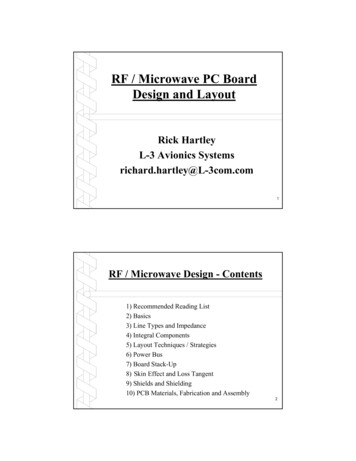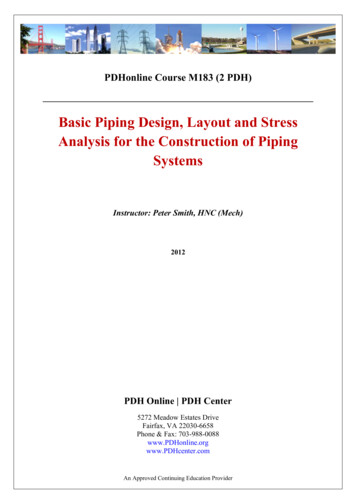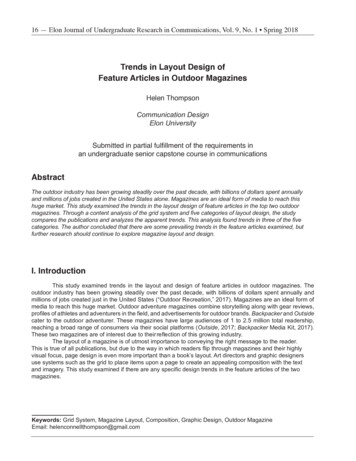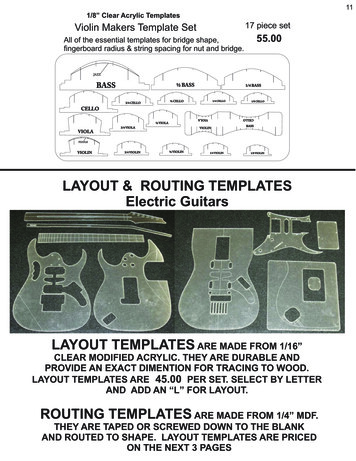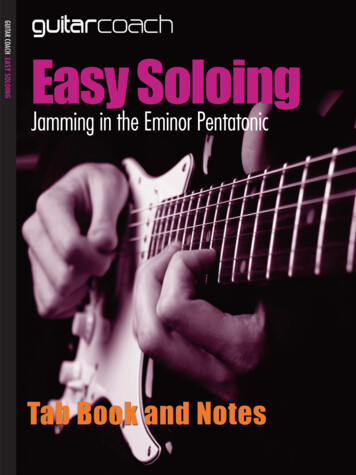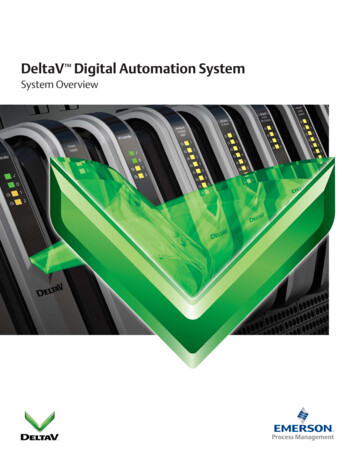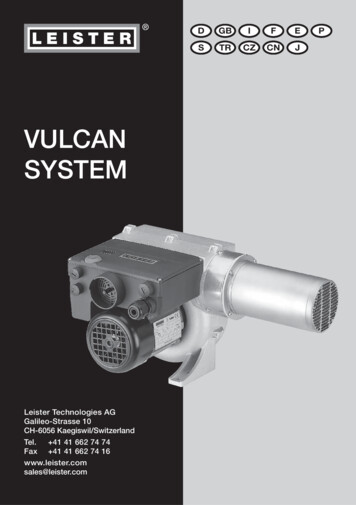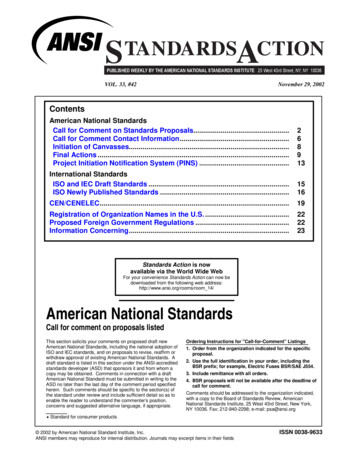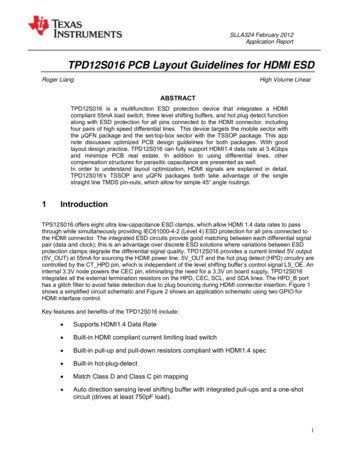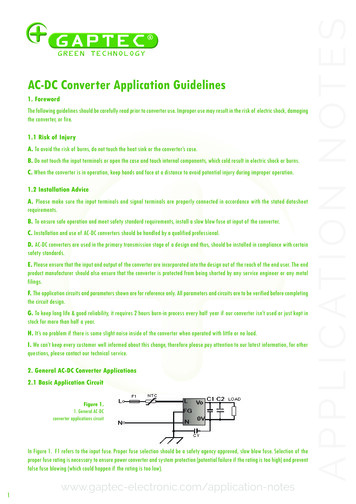
Transcription
1. ForewordThe following guidelines should be carefully read prior to converter use. Improper use may result in the risk of electric shock, damagingthe converter, or fire.1.1 Risk of InjuryA. To avoid the risk of burns, do not touch the heat sink or the converter’s case.B. Do not touch the input terminals or open the case and touch internal components, which cold result in electric shock or burns.C. When the converter is in operation, keep hands and face at a distance to avoid potential injury during improper operation.1.2 Installation AdviceA. Please make sure the input terminals and signal terminals are properly connected in accordance with the stated datasheetrequirements.B. To ensure safe operation and meet safety standard requirements, install a slow blow fuse at input of the converter.C. Installation and use of AC-DC converters should be handled by a qualified professional.D. AC-DC converters are used in the primary transmission stage of a design and thus, should be installed in compliance with certainsafety standards.E. Please ensure that the input and output of the converter are incorporated into the design out of the reach of the end user. The endproduct manufacturer should also ensure that the converter is protected from being shorted by any service engineer or any metalfilings.F. The application circuits and parameters shown are for reference only. All parameters and circuits are to be verified before completingthe circuit design.G. To keep long life & good reliability, it requires 2 hours burn-in process every half year if our converter isn’t used or just kept instock for more than half a year.H. It’s no problem if there is some slight noise inside of the converter when operated with little or no load.I. We can’t keep every customer well informed about this change, therefore please pay attention to our latest information, for otherquestions, please contact our technical service.2. General AC-DC Converter Applications2.1 Basic Application CircuitFigure 1.1. General AC-DCconverter applications circuitIn Figure 1. F1 refers to the input fuse. Proper fuse selection should be a safety agency approved, slow blow fuse. Selection of theproper fuse rating is necessary to ensure power converter and system protection (potential failure if the rating is too high) and preventfalse fuse blowing (which could happen if the rating is too low).1www.gaptec-electronic.com/application-notesA P P L I C AT I O N N O T E SAC-DC Converter Application Guidelines
I 3 x Vo1 x Io1 / η / Vin (min.)Vo1 output voltageIo1 output currentη the converter’s efficiencyVin (min) the minimum input voltageFuther circuit notations:- NTC is a thermistor.- CY and CX are safety capacitors.- C1 is a high frequency ceramic capacitor or polyester capacitor, 0.1μF/50V.- C2 is output filtering high frequency aluminum electrolytic capacitor. Select a 220μF rating if the output current is greater than5A, or a 100μF rating if the output current is less than 5A. The insulation voltage should be derated to less than 80% of ratedvalue.For dual or triple output converters, the circuit of input side remains the same and the outputs should be considered independentlyin component selection (see Figure 3). The application circuit shown in Figure 1. is typical application circuit, whereby all GAPTECproducts will meet EMI Class B, and Class 3 lightening strike and surge testing (see datasheets for more details). To comply with morestringent EMC testing, additional filtering should be incorporated.See Figure 2. for a suggested filtering circuit:Figure 2.Input filter circuitFigure 3.Typical application circuitFor multi-output converters, the main output is typically a fully regulated output. If the end application requires critical regulation onthe auxiliary output(s), a linear regulator or other regular should be added after the converter.Please note: Some converters have built in linear regulators; please contact our technical support for more -notesA P P L I C AT I O N N O T E SBelow is the formula to calculate the proper rating:
3.1 Marking RequirementsWherever there are fuses, protective grounds, or switches, clear symbols should be indicated according safety standards. Touchabledangerous high voltage and energy sources should be marked with “Caution!” indications.3.2 Input Cable Requirements:Input cables of L, N and E should be brown, blue and yellow/green cables, respectively. Ensure that the ground cable (yellow & greencable) of Type I devices (those that rely on basic insulation and protection ground to avoid electric shock) are securely connected tothe ground, and the earth resistance is lower than 0.1Ω3.3 Clearance and CreepageFor Type I devices, ensure:- L and N are in front of the fuse.- The clearance distance between the input and the metal case is above 2mm and creepage is above 2.5mm.For Type II devices (those that rely on strengthened insulation or double insulation to avoid electric shock) ensure:- L and N are in front of the fuse- The clearance distance between the input and the metal case is above 2mm and creepage is above 2.5mm.- The clearance between the input and the metal case or SELV is above 4mm, and creepage of that is above 5mm.3.4 Input energyIf the input capacitor is large, a discharge resistor may be added to ensure that, after disconnect, the voltage held betweenInput L, N, and the protective ground will be discharged to 37% of its maximum value or below. In Figure 2, R1 is the dischargeresistor.4. Heat Dissipation in AC-DC Converter Module ApplicationsTrends toward higher density in AC-DC module designs make heat dissipation an important concern. The effect of heat on the electrolyticcapacitor is of particular concern, as the life of such capacitors can be drastically reduced when operated in a constant high temperatureenvironment, leading to a higher potential for failure. Proper handling of heat will increase the life of the converter and surroundingcomponents, thus lowering risk of failures. Some suggestions for handling dissipated heat are summarized, below:(1) Ambient Air CoolingFor miniature and high power density converters, free air cooling is recommended, mainly due to cost and space concerns.- Heat dissipates to the ambient air through the converter case or exposed surfaces. Heat may also dissipate to ambient air ifthere is a gap between the converter and the PCB.- Heat dissipates from the converter case and exposed surfaces to PCB by radiation.- Heat conducts through terminals (pins) to PCB.Figure 4.Converter assembled on PCB3www.gaptec-electronic.com/application-notesA P P L I C AT I O N N O T E S3. AC-DC Converter Safety Related Design Notes
A. Air FlowBecause the heat dissipation is mainly through convection and radiation, the converter needs an environment with good air flow.It may be helpful to design heat dissipation venting holes throughout the end product, near the converter’s location. For best convectioncooling, ensure that air flow is not blocked by large components.B. Layout of Heat Generating ComponentsIn most applications, the AC-DC converter is usually not the only heat generating component. It is recommended to keep a gooddistance between each heat generating component to minimize heat dissipating clusters.C. PCB DesignThe PCB, which the power converter is assembled on, is not only a base to mount the converter, but also acts as a heat sink for it,therefore heat dissipation should be considered in PCB layout. We recommend to extend the area of the main copper loop and decreasethe component density on the PCB to improve the ambient environment.(2) Heat SinksWhen free air convection is insufficient, we recommend the use of a heat sink for further cooling. As the converters are filled withheat conductive silicon or epoxy, the heat distribution in converters is even and it radiates from the converter to the air. The efficiencyof this convection is dependent on the size of the surface area of the converter. The use of heat sinks is a practical method to addsurface area and improve the convection. There are many kinds of heat sinks available in the market. GAPTEC recommends consideringthe following factors in selecting a heat sink:- The heat sink should be made of a good heat conducting material, such as aluminum and copper.- The larger the surface area, the better the radiation. Therefore, heat sinks usually have a ridged surface or special coatings to makea larger surface area.- Use the longest and thickest possible heat sink for best convection.Heat sinks are best attached to the converter’s surface, where the difference in temperature between the surface and the ambient islargest. The use of heat conductive material between the heat sink and the converter’s surface to make a better contact and to improveheat conductance is suggested. To avoid case distortion, please do not affix the heat sink too firmly to the converter case.(3) Forced Air CoolingIn some systems, where a heat sink does not effectively reduce the ambient temperature, a fan is used to improve the heat radiation.Fans can lower the surface temperature of the converter, but large fans also occupy extra space in the system. It is important to selecta suitable fan size, where the speed of the fan will determine how effective it is. The faster the speed, the better the effect on reducingradiated heat. As high speed will also cause increased noise, there is a need to balance the choice between how effective the fanshould be against how much audible noise it generates.A long, rectangular shaped AC-DC converter should use a horizontal fan, and channeled heat sinks should use vertical fans, in orderto encourage air flow through the tesA P P L I C AT I O N N O T E SIn such as before mentioned applications, please pay particular attention to:
5.1 Block Diagram of AC-DC ConverterFigure 5.Rectifier filtering5.2 Impact to Converter ReliabilityThe input voltage range of GAPTEC’s AC-DC converters is 85 264VAC or 120 370VDC. When the converter is operated within therated input voltage range, the output current can be used up to the maximum rated specification. The total output power is Io x Vo.If the converter is operated with an input voltage that is under the rated voltage, offering the same output power of Io x Vo, causesthe current (Is) at the transistor (S) to be increased. Long term operation under this condition will damage the transistor (S).5.3 Input Voltage vs Load Capability (3ACA 3R sA P P L I C AT I O N N O T E S5. Input Under Voltage Impact
When free air convection is insufficient, we recommend the use of a heat sink for further cooling. As the converters are filled with heat conductive silicon or epoxy, the heat distribution in converters is even and it radiates from the converter to the air. Th e efficiency of this convection is dependent on the size of the surface area of the converter. The use of heat sinks is a practical .

